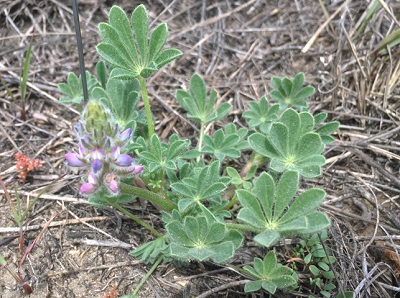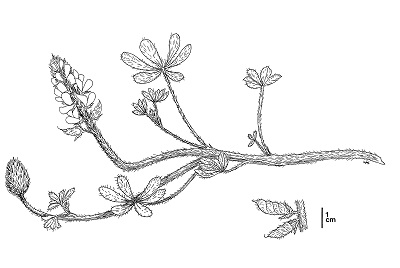 Lupinus nipomensis. U.S. Fish and Wildlife photo by Kristie Scarazzo.
Lupinus nipomensis. U.S. Fish and Wildlife photo by Kristie Scarazzo.
 Lupinus nipomensis. CDFW illustration by Mary Ann Showers.
Lupinus nipomensis. CDFW illustration by Mary Ann Showers.
Nipomo Mesa lupine is a California endangered plant species, which means that killing or possessing any part of the plant is prohibited by the California Endangered Species Act (CESA). This species is also listed as endangered under the federal Endangered Species Act (ESA). There is currently only one known population of Nipomo Mesa lupine consisting of approximately 700 plants. This population has been divided into three occurrences in the California Natural Diversity Database (CNDDB). Occurrence one is a natural subpopulation growing on privately owned land; occurrence two is extirpated (no longer thought to exist); and occurrence three is an established outplanting site. The Nipomo Mesa lupine’s range is limited to approximately two square miles and the species is restricted to stabilized back sand dunes within the Guadalupe-Nipomo Dunes complex in San Luis Obispo County.
Nipomo Mesa lupine is an annual herb in the legume family (Fabaceae). It grows to approximately 4-8 inches in height and has a basal rosette of segmented leaves that are covered with soft white hairs. Nipomo Mesa lupine produces dense clusters of lavender pea-like flowers and blooms from December to March. The succulent fruits of Nipomo Mesa lupine are also covered in white hairs that disappear with age. Each fruit produces three to five seeds. These seeds have a thick seed coat that requires some type of abrasion to germinate, indicating that this species may form a persistent seed bank in the soil. Germination is thought to be initiated in autumn when adequate rainfall saturates the soil and moistens the seeds.
Nipomo Mesa lupine occurs in areas with beaches and sand dunes that are derived from sand deposits that are less than 2.6 million years old. The unique geology of this area suggests that the range of the species has always been narrow. Nipomo Mesa lupine is associated with coastal dune scrub vegetation communities that include plants such as sand verbena (Abronia umbellata), fiddleneck (Amsinckia spectabilis), purple owl’s clover (Castilleja exserta), mock heather (Ericameria ericoides), miniature lupine (Lupinus bicolor), and dune baby blue eyes (Phacelia douglasii).
The geographic range of Nipomo Mesa lupine has diminished due to agricultural, industrial, and suburban development. The primary threats to this species are displacement and habitat loss from invasive species like veldt grass (Ehrharta calycina), development activities, seed predation, and climate change. Low genetic diversity due to the small population size, a lack of known pollinators, dependence on ample seasonal rainfall for seed germination, and the lack of suitable habitat have added to the complexity of recruitment and restoration efforts.
The continued survival of Nipomo Mesa lupine will require annual monitoring of existing occurrences, seed banking, outplanting efforts in remaining suitable habitat, and restoration and management of existing occurrences which will likely involve removal of veldt grass and other invasive plant species.
CDFW may issue permits for scientific research and recovery of Nipomo Mesa lupine pursuant to CESA, and you can visit our website to learn more about the California laws protecting Nipomo Mesa lupine and other California native plants. Populations of Nipomo mesa lupine occur in CDFW’s Central Region. More information is also available from the U.S. Fish and Wildlife Services Species Profile for Nipomo Mesa lupine.
Updated: May 4, 2020